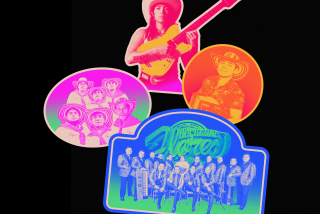<i> Que</i> Cool! : So long, techno. <i> Banda</i> music is here, and with it, hotter than a jalapeno, is the latest dance: <i> la quebradita</i> .
Itâs noon in South Los Angeles, and the more than 500 kids packed shoulder-to-shoulder into a multipurpose room at Gage Middle School have one thing on their minds: the summerâs biggest dance craze-- la quebradita --danced to the summerâs newly popular sound, banda .
Hotter than a jalapeno, the dance fever has been gaining steam among Latino teen-agers--particularly those of Mexican descent--and now it seems to have burst onto the scene, dominating CD players at junior high and high school dances, quinceaneras and parties from East Los Angeles to Lynwood, from Hollywood to Huntington Park.
Que cool!
At Gage, where the majority student enrollment is Latino and English is the second language spoken at home, quebraditas , as the bailes (or dances) are commonly known, have been in demand since a quebradita dance club formed a few months ago.
It was then that a handful of students armed with banda cassettes--Mexican music played with the festive horns and oom-pah bass of German polka bands--began meeting every Friday to enjoy la quebradita, a dance that combines country-Western with cumbia, salsa and occasionally flamenco. The dance gets it name, la quebradita (âthe little breakâ), when one partner, usually the guy, swings his mate into a backward bend and, balancing her body in one arm, barely brushes her against the floor while rocking to the beat.
For sure, this is not the Mexican hat dance. Itâs more like lambada meets limbo rock.
And on this particular Friday, la quebradita is getting down at Gage.
There are no wallflowers here. Everyone--with and without partners, in groups of three to five and more, guys dancing solo, girls dancing together, even teachers, counselors and school principal Jose Caldera--is grooving to the Mexican music. Theyâre singing along to the Spanish lyrics of lost loves, new romances, sad memories and pride in being Mexican.
Forget house music. Deep-six techno. And if you want to get out of here alive, donât even mention rap.
Louie Guzman, a 23-year-old teacherâs assistant and part-time deejay doesnât dare throw down Dr. Dre on his CD player. âNot in this crowd. Are you kidding? Iâll get booed,â he shouts above the pulsating music of Banda Vallarta Show, a popular group he intersperses with Banda Movil, Banda Machos and Banda Jinetes.
âIâve done it before just to see what kind of music they want,â says Guzman, who danced to funk during his Gage heyday and is âshocked and amazedâ at the quebradita trend. âAnd right now they want banda . They want to dance quebradita .â
These kids are even dressed for it. Thereâs not one saggy, baggy blue jean in the lot. Instead, quebradita dancers have adopted a ranchero , or cowboy, look to carry off the total experience.
For girls, itâs a style that includes black stretch tops, tight-fitting jeans with belt buckles the size of hubcaps, and cowboy boots. For guys, the look is carried off with button-fly jeans, hats (usually made of straw or felt), fringed leather vests and boots so shiny you can see your reflection in them.
Rear pockets are draped with a correa, or a leather strap, engraved with the name of a Mexican state--Michoacan, Colima, Jalisco, Zacatecas--to signify a dancerâs birthplace. For those who canât plunk down $15 for a correa, thereâs an $8 folded bandanna with the stateâs name embroidered on it in red and green, the colors of the Mexican flag. It suits the purpose and fills the wearer with just as much pride.
La c uarta , or a shorter variation of a horsewhip, is wrapped around a belt loop and dangles to just below the knee. Itâs used in several dances, for effect, by whipping the sides of oneâs boots.
âWeâre like Mexican cowboys when we are dancing quebradita -style,â says Ivan Coronado, 12, whose correa declares him from the state of Sinaloa. Ivan and his family emigrated to California four years ago.
The seventh-grader is in fine form as he switches off partners in a group of dancers who mix it all up: ranchero steps with polka and restrained rocanrol moves. With a little bit of encouragement Ivan doesnât miss a beat as he twirls his blue-gray cowboy hat on his fingertip to shouts and applause.
âThis is part of my culture,â Ivan says. âMy parents like nortena (accordion-based music) and ranchera (guitar-based music.) I like banda .â
And he loves to dance.
So does Karen Velasquez, 12, who came to the United States from Colima two years ago.
âEver since I was little we always grew up with music in our home, with Mexican music,â she says, while sitting out a song by Banda Superbandidos. âI like dancing quebradita mainly because it reminds me of Mexico and this is the dance and music of Mexico and Los Angeles. Itâs a combination of the two. When Iâm dancing it makes me feel happy.â
Like his friends, Alfonso Mendez, 14, says the banda music and quebradita dancing fill a cultural void for the teen-ager from Jalisco who emigrated with his family to Los Angeles five years ago.
âI like all kinds of music--rap and techno because thatâs the kind of music that I got used to when we came to the United States. But I have never given up on Mexican music,â he says, adding that when KLAX-FM (97.9)--known as La Equis (pronounced La EH-kees)--started playing only banda music last summer, he and thousands of other listeners got hooked.
Alfonso and his friends often frequent nearby flea market dances to watch grown-ups dance to banda , to study the latest banda fashions--(âIf you donât have the whole outfit, you just look incomplete,â Alfonso says)--and to pick up on the latest dance steps.
He coaxes Lucia Espinoza, a teacherâs assistant who sponsors the Quebradita Club at Gage, onto the dance floor. Soon they and others are doing a hip-hop variation of a flamenco foot-stomping dance called the zapateado ; another called El Borracho de El Paso (the drunk from El Paso) where dancers stage staggering steps in a country-Western line dance; and a quebradita conga line.
Says Espinoza: âMy kids love this dance and music because it is a part of their culture, a part of life in their homes, in their neighborhoods where it originated. Itâs from the street, from East L.A., from being proud of being Mexican and Mexican-American.â
âThatâs why I love it,â he adds. âItâs music and dancing that we can claim as our very own.â
More to Read
Sign up for Essential California
The most important California stories and recommendations in your inbox every morning.
You may occasionally receive promotional content from the Los Angeles Times.










